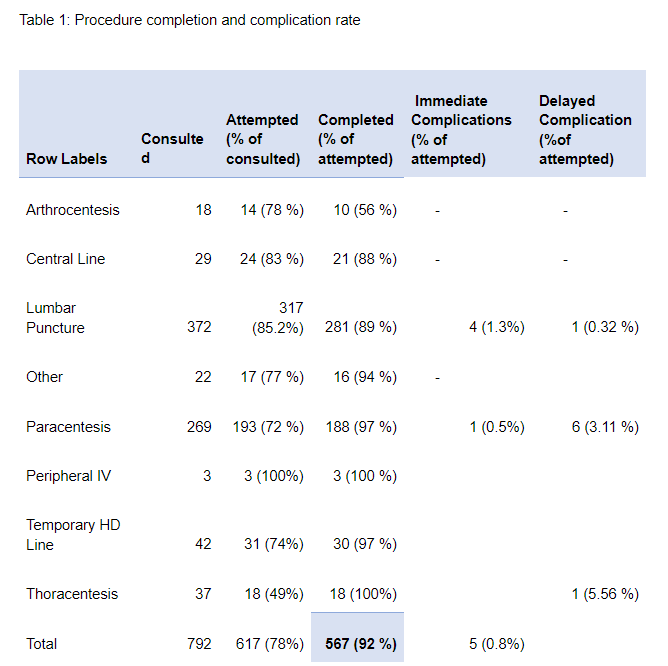Background: Internal medicine and hospital medicine providers are under pressure to move patients quickly through the hospital and decrease length of stay. Providers spend most of their clinical time seeing patients, documenting or coordinating care and have minimal time to disrupt workflow to perform common bedside procedures such as paracentesis, lumbar punctures, central lines, arthrocentesis and thoracentesis. Combining this shift in clinical workflow with the ABIM’s stance on these procedures not being required to graduate residency, has led to providers being uncomfortable with performing these procedures. Procedures then get redirected to subspecialty services or Interventional Radiology (IR) resulting in potential delays in patient care. We sought to tackle these problems with a pilot procedure service run by hospitalists at a large academic hospital with both teaching and direct care internal medicine service lines.
Purpose: Our mission was to start a dedicated procedure service to alleviate some of the issues. A cadre of well trained hospitalists can perform these procedures safely and efficiently. Through this endeavor we aim to improve throughput for hospitalized patients needing bedside procedures, standardize the performance of the procedure, provide direct observation and supervision to trainees, while providing a safe and efficient service to our patients. The downstream effects would lead to decreased length of stay, improved billing, decreased use of radiology suites for simple procedures.
Description: We started a consult based hospitalist run procedure service starting October 1, 2019. We started with five hospital medicine attending physicians who underwent procedure training prior to the start of the service with expansion and further training in progress. The procedures offered were abdominal paracentesis, thoracentesis, central venous catheter placement, lumbar punctures, arterial lines and arthrocentesis. Ultrasound equipment and physician time was funded through the Division of Hospital Medicine. Procedure service was available every day from 7am to 5pm, including weekends, through a dedicated pager. A REDCap database was created to capture data for consult volume, completion, type of procedure and complications. Several other procedure specific and system specific data were collected.
Conclusions: The procedure team was consulted 792 times since the initiation of the team. This consisted of 372 lumbar punctures, 29 central venous lines, 18 arthrocentesis, 42 temporary hemodialysis access lines, 269 abdominal paracentesis and 37 thoracentesis procedures, of which 617 (78%) were attempted, and 567 were completed. Aborted or failed procedure rate was 8.1% (Table 1). Procedures were refused/ not attempted typically due to either patient refusal, unsafe clinical scenarios, or updated clinical status. Procedure complications were rare, and typically minor such as bloody lumbar puncture tap or persistent leak from paracentesis. One paracentesis resulted in severe bleeding and one thoracentesis resulted in bleeding causing a Hemoglobin drop. Overall, hospitalists were able to complete procedures with a median time of less than 4 hours

